Recent Posts
8 Tips to Prevent Mold in Your Vacation Rental
7/17/2024 (Permalink)
 Our SERVPRO of San Diego East team can provide detailed advice and services to keep your property in excellent condition.
Our SERVPRO of San Diego East team can provide detailed advice and services to keep your property in excellent condition.
As a vacation rental owner, maintaining a mold-free property is essential for ensuring guest satisfaction and protecting your investment. Mold can quickly turn a guest’s dream vacation into a nightmare and result in negative reviews, which can hurt your rental business. Here’s how you can protect your vacation rental from mold with some effective strategies.
Keeping Your Vacation Rental Mold-Free
- Regular Inspections
Make it a routine to inspect your property for signs of mold and moisture, especially before and after the property is occupied. Check common problem areas like bathrooms, kitchens, and any places with plumbing. Look for water stains, leaks, or condensation issues, which are precursors to mold growth.
- Enhance Air Circulation
Proper ventilation is crucial in preventing mold. Ensure that your property has adequate airflow. Use ceiling fans, exhaust fans, and occasionally open windows to help reduce moisture. Encourage guests to use bathroom and kitchen fans regularly to keep air moving.
- Control Humidity
Invest in a good-quality dehumidifier to help maintain the humidity levels below 60%, which is recommended to hinder mold growth. In humid climates, this can be especially important in preventing the damp conditions in which mold thrives.
- Quick Response to Water Problems
Any spills, leaks, or flooding should be addressed immediately to prevent the moisture from seeping into floors, walls, and furniture. Make sure your guests know how to contact maintenance quickly in case of such issues.
- Use Mold-Resistant Products
When updating or repairing your rental, choose mold-resistant materials such as paints, drywall, and fabrics. These products can be particularly effective in high-moisture areas like bathrooms and kitchens.
- Keep It Clean
Regular and thorough cleaning can help prevent mold growth. Ensure that bathrooms and kitchens are kept dry and well-ventilated. Provide guests with cleaning supplies and encourage them to wipe down surfaces where moisture may accumulate.
- Maintain Gutters and Drainage
Ensure that your property’s gutters are clean and free from debris to prevent water buildup. Proper exterior drainage is also crucial to steer water away from the foundation, which can be a significant factor in preventing mold.
- Educate Your Guests
Include information in your welcome book about the importance of preventing mold, such as using exhaust fans and managing humidity. Simple guidelines can empower guests to help maintain the property during their stay.
Protecting your vacation rental from mold is crucial for the longevity of your property and the satisfaction of your guests. Regular inspections, proper humidity control, and good cleaning practices are key strategies to prevent mold. By taking these proactive steps, you can ensure that your property remains a top choice for vacationers looking for a comfortable and healthy place to stay.
For more information on mold prevention and maintenance for vacation rentals, consider consulting with mold remediation professionals, such as our SERVPRO of San Diego East team, who can provide more detailed advice and services to keep your property in excellent condition.
Flood Damage vs. Water Damage: Key Differences
6/12/2024 (Permalink)
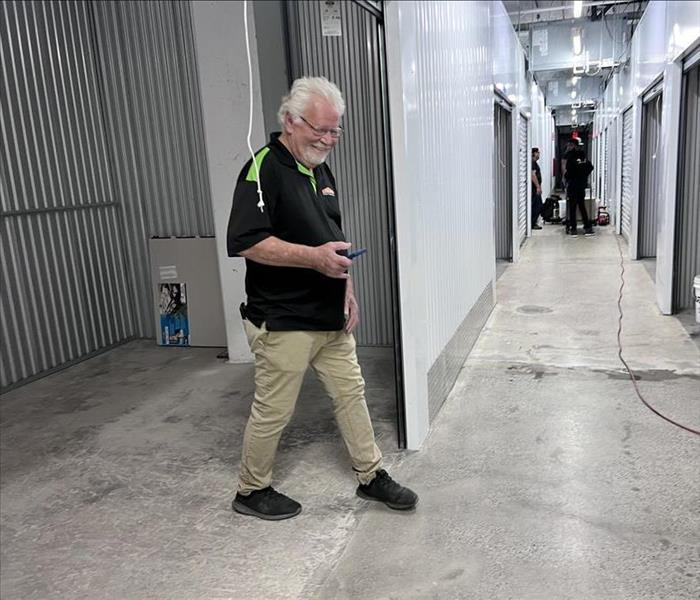 Our team is knowledgeable in the key differences between flood damage and water damage.
Our team is knowledgeable in the key differences between flood damage and water damage.
Water damage is a common issue that homeowners may encounter, whether caused by a burst pipe, leaky roof, or plumbing malfunction. However, when it comes to the extent and severity of damage, there are distinct differences between water damage and flood damage. Understanding these differences is crucial for taking the appropriate actions and seeking professional assistance. In this blog, we will discuss the key differences between flood damage and water damage.
Causes of Damage
One of the primary distinctions between flood damage and water damage lies in their causes. Water damage typically arises from internal sources within the home, such as faulty appliances, burst pipes, or damaged roofs. These incidents are often localized and can affect specific areas or rooms within the property.
On the other hand, flood damage occurs as a result of external water sources, such as heavy rain, rising rivers, or coastal storm surge. Floodwater can infiltrate various parts of the property, affecting multiple rooms or even the entire structure.
Severity and Volume
Flood damage is generally more severe and extensive compared to typical water damage incidents. Floodwater is often widespread, covering large areas and affecting multiple levels of a property. The volume and pressure of floodwater can cause significant damage to walls, foundations, flooring, and other structural elements.
Water damage, while still significant, is usually contained within a specific area or room. The volume of water involved may be smaller, but it can still lead to significant damage if not addressed promptly. However, water damage from sources like burst pipes or malfunctioning appliances can quickly escalate if left unresolved.
Types of Water
The type of water involved in the damage is another critical distinction. Floodwater is classified as Category 3 or black water, which is highly contaminated and poses potential health risks. It can contain sewage, chemicals, debris, and other hazardous substances. Due to its unsanitary nature, professional remediation and proper precautions are necessary when dealing with flood damage.
Water damage from internal sources is typically Category 1 or clean water, which poses minimal health risks. Clean water may come from a broken supply line, faucet, or other freshwater sources. However, if left untreated or unresolved, clean water can become contaminated and escalate to higher categories, requiring more extensive remediation.
Insurance Coverage
Insurance coverage is often another differentiating factor between flood damage and water damage. While standard homeowners' insurance policies usually cover water damage from internal sources, such as burst pipes or plumbing leaks, they may not provide coverage for flood damage.
Flood damage is typically covered under a separate flood insurance policy that homeowners can purchase through the National Flood Insurance Program (NFIP) or private insurers. It's essential for homeowners in flood-prone areas to have flood insurance in place to protect their property from flood-related damages.
Understanding the differences between flood damage and water damage is crucial for homeowners to take appropriate actions and seek professional assistance promptly. Whether dealing with flood damage or water damage, it is essential to engage certified restoration professionals like SERVPRO® for efficient and thorough remediation. If you require assistance with flood or water damage restoration, contact SERVPRO for expert and reliable restoration services tailored to your specific needs.
Safeguarding Your Valuables from Storm Damage
5/15/2024 (Permalink)
Storms can wreak havoc on your home, causing significant damage to your property and belongings. While it's essential to prepare your home for storms and take preventive measures, safeguarding your valuables is equally important. In this blog, we'll explore effective ways to protect your valuables from storm damage, ensuring that your most prized possessions remain safe and secure.
Create a Home Inventory
Before a storm strikes, it's crucial to create a detailed home inventory of all your valuables. This inventory should include items such as jewelry, important documents, electronics, artwork, and sentimental items. Documenting your possessions will not only help you assess potential damage post-storm but also assist you in filing insurance claims if needed.
Consider taking photographs or videos of your valuables and storing them in a safe place or digitally in the cloud. Having a comprehensive inventory will enable you to account for all your belongings and streamline the restoration process in case of storm damage.
Invest in Waterproof Containers
Water damage is a common consequence of storms, particularly flooding. To protect your valuables from water damage, invest in waterproof containers or safes. Store important documents, jewelry, and other valuables in these containers to shield them from water infiltration during a storm.
Place the containers in elevated areas of your home to minimize the risk of water exposure. Additionally, consider storing digital copies of important documents on a secure external hard drive or a cloud storage platform for added protection.
Secure Valuables in a Safe
For valuable items such as jewelry, cash, and important documents, consider storing them in a fireproof and waterproof safe. Safes offer an additional layer of protection against storm damage, theft, and fire hazards. Opt for a safe with a high fire and water resistance rating to ensure maximum protection for your valuables.
Place the safe in a secure and easily accessible location within your home, such as a closet or basement. Remember to regularly update the contents of the safe and maintain the safe's security features for enhanced protection.
Utilize Shelving and Storage Solutions
Organizing and storing your valuables on high shelves or elevated platforms can prevent water damage during a storm. Utilize sturdy shelves, cabinets, or storage solutions to keep your valuables off the ground and out of harm's way.
Install shelving units in your home office, garage, or storage areas to store items such as electronics, collectibles, and sentimental objects. By elevating your valuables, you reduce the risk of water exposure and potential damage during a storm.
Consider Off-Site Storage
In preparation for severe storms, consider storing your valuables in an off-site storage facility. Renting a storage unit or utilizing a safe deposit box at a bank can safeguard your valuables from home damage caused by storms.
Transfer items of high value, sentimental significance, or irreplaceable nature to an off-site location for safekeeping. Ensure that the storage facility is secure, climate-controlled, and equipped to protect your belongings from storm damage.
Conclusion
Protecting your valuables from storm damage is essential in safeguarding your most cherished possessions and assets. By creating a home inventory, investing in waterproof containers, securing valuables in a safe, utilizing shelving solutions, and considering off-site storage options, you can mitigate the risk of damage during a storm.
In the unfortunate event of storm damage, contact SERVPRO® for professional storm damage recovery and restoration services. Our experienced team is equipped to handle the restoration of your home and belongings with efficiency and care, ensuring that your property is restored to its pre-storm condition.
Prioritize the protection of your valuables and take proactive measures to safeguard them from storm damage. By implementing these strategies, you can minimize the impact of storms on your most treasured possessions and maintain peace of mind during inclement weather.
The benefits of installing fire-rated doors and windows
4/9/2024 (Permalink)
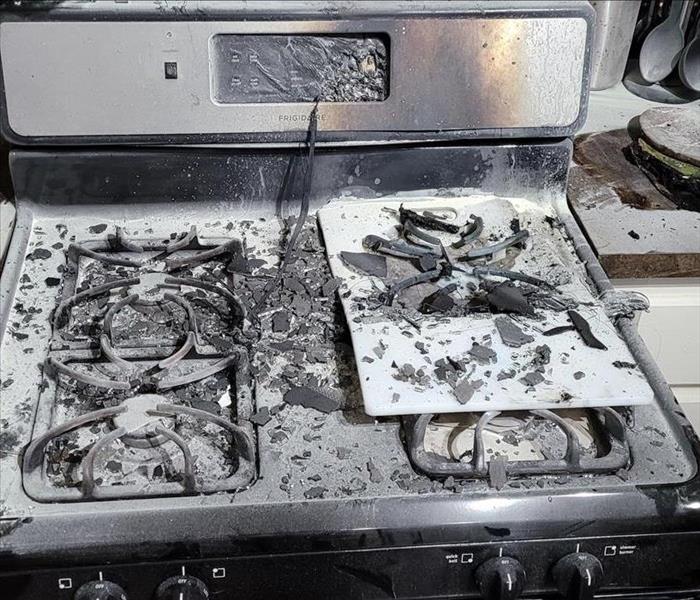 Prevent fire disasters with some preparedness before disaster strikes.
Prevent fire disasters with some preparedness before disaster strikes.
As a trusted leader in the restoration and cleanup industry, SERVPRO® is committed to not only responding to disasters but also preventing them. In this blog post, we're going to shed light on a crucial aspect of fire safety—installing fire-rated doors and windows. Understanding the benefits of these installations can be a game-changer for both residential and commercial properties.
Containment of Fire Spread
Fire-rated doors and windows play a pivotal role in containing the spread of flames. In the unfortunate event of a fire, these specialized structures act as barriers, preventing the fire from rapidly advancing through a building. This containment can significantly minimize property damage and enhance the safety of occupants.
Increased Escape Time
Time is of the essence during a fire emergency. Fire-rated doors and windows provide occupants with precious additional minutes to evacuate safely. This added escape time can be the difference between a successful evacuation and potential injuries.
Protection of Valuables
Beyond personal safety, fire-rated doors and windows safeguard valuable assets and critical documents within a property. By impeding the fire's progress, these installations give firefighters more time to respond effectively, potentially saving both property and irreplaceable items.
Compliance with Building Codes
Installing fire-rated doors and windows ensures compliance with local building codes and regulations. Authorities often require these safety features, and meeting such standards not only keeps occupants safe but also prevents legal complications for property owners.
Insurance Premium Reductions
Property owners who prioritize safety by installing fire-rated doors and windows may enjoy reduced insurance premiums. Insurers recognize the added protection these features provide, leading to potential cost savings over the long term.
Enhanced Property Value
Safety features, such as fire-rated doors and windows, contribute to the overall value of a property. Prospective buyers or tenants often prioritize safety when considering a place to live or conduct business. Investing in these measures can make your property more attractive in the market.
Peace of Mind for Occupants
Perhaps the most significant benefit of all is the peace of mind that fire-rated doors and windows bring to occupants. Knowing that their safety is prioritized provides a sense of security, fostering a more positive living or working environment.
The installation of fire-rated doors and windows is a proactive step toward mitigating the devastating effects of a fire. At SERVPRO, we encourage property owners to prioritize safety and take preventive measures. For more information on fire safety and disaster preparedness, feel free to reach out to our experts. Your safety is our priority, from prevention to restoration.
Everything You Need to Know About Bathroom Mold: Causes, Prevention, and Removal
3/13/2024 (Permalink)
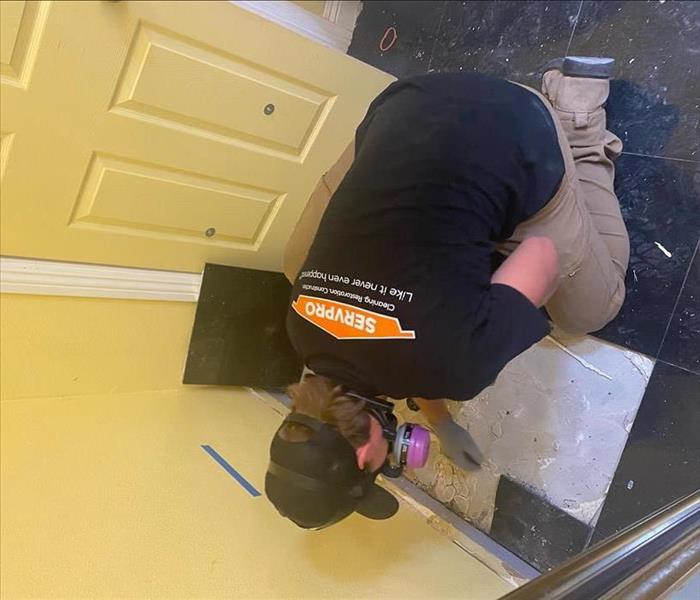 In this blog, we will explore the causes, prevention, and removal of mold in the bathroom.
In this blog, we will explore the causes, prevention, and removal of mold in the bathroom.
Mold growth in the bathroom is a common problem due to the high moisture levels found in this area. Not only is bathroom mold unsightly, but it can also deteriorate surfaces and cause potential health risks. Understanding the causes of bathroom mold, implementing preventive measures, and knowing how to effectively remove it is essential for maintaining a clean and healthy bathroom environment. In this blog, we will explore the causes, prevention, and removal of mold in the bathroom.
Causes of Mold in the Bathroom
Excess Moisture: Bathrooms are prone to excess moisture due to activities like showering, bathing, and washing. This moisture, along with the lack of ventilation, creates an ideal breeding ground for mold spores to grow and thrive.
Poor Ventilation: Inadequate ventilation can lead to moisture buildup, encouraging mold growth. Bathrooms with no or insufficient windows, exhaust fans, or proper airflow can trap moisture and promote the development of mold.
Leakages: Leaking pipes, faucets, and fixtures contribute to excess moisture in the bathroom. These hidden sources can go unnoticed for an extended period, creating the perfect environment for mold to flourish.
Prevention of Mold in the Bathroom
Proper Ventilation: Install an exhaust fan or use a window to facilitate air circulation and remove excess moisture from the bathroom. Ensure the fan is appropriately sized for the room and vented to the outside to prevent mold spores from circulating back into the bathroom.
Regular Cleaning: Regularly clean and dry bathroom surfaces to prevent mold growth. Wipe down wet surfaces such as shower walls, tubs, and sinks after each use. Use a squeegee or towel to remove excess moisture and discourage mold growth.
Fix Leaks: Promptly repair any leaks or water damage in pipes, faucets, or fixtures to prevent moisture accumulation. Regularly inspect and maintain plumbing systems to avoid potential mold problems.
Reduce Humidity: Use a dehumidifier or open windows to reduce humidity levels in the bathroom. Lowering humidity discourages mold growth and promotes a healthier bathroom environment.
Removal of Mold from the Bathroom
Safety Precautions: Before starting the mold removal process, take necessary safety precautions, such as wearing gloves, goggles, and a mask to prevent exposure to mold spores. Ensure the area is well-ventilated to minimize inhalation of mold particles.
Cleaning Products: Use mold cleaning products that are specifically designed for bathroom mold remediation. Look for products that contain ingredients such as sodium hypochlorite or hydrogen peroxide, which are effective in killing mold spores. Follow the instructions on the product for proper use and safety.
Scrubbing and Drying: Scrub the moldy area with a brush or sponge and the mold cleaning product. Thoroughly rinse the area and ensure it is completely dry. Drying the area prevents further mold growth and reduces the chances of moisture-related issues.
Professional Mold Remediation: When dealing with extensive or persistent mold growth, it is advisable to seek professional mold remediation services. Trained professionals, like SERVPRO®, can accurately assess the extent of mold damage, ensure proper removal, and address the underlying causes to prevent future mold recurrence.
Preventing and removing mold in the bathroom is vital for maintaining a clean and healthy environment. By addressing the causes of bathroom mold, implementing preventive measures, and using appropriate cleaning products, you can effectively control mold growth. Regular cleaning, proper ventilation, and prompt repair of leaks are key preventive strategies. If mold growth persists or becomes extensive, it is best to consult professionals to ensure thorough and safe mold remediation.
Everything You Need to Know About Drying Equipment
2/20/2024 (Permalink)
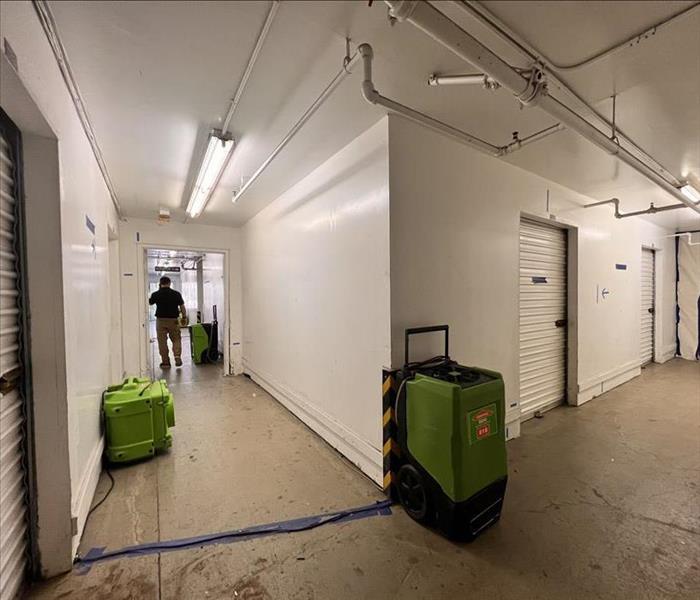 The success of drying techniques lies in the balance of various tools and methods.
The success of drying techniques lies in the balance of various tools and methods.
Water damage can be a homeowner's nightmare, but fear not – efficient drying techniques are the unsung heroes in the battle against water leaks. Let's demystify the workings of essential drying equipment such as air movers and dehumidifiers.
1. Air Movers: The Powerhouse of Evaporation
Air movers, often resembling high-powered fans, play a crucial role in accelerating the evaporation process. By creating a continuous flow of air across wet surfaces, they enhance moisture evaporation, turning water into water vapor. This swift evaporation is essential in preventing stagnant water, minimizing the risk of mold growth, and expediting the overall drying process.
2. Dehumidifiers: Moisture's Nemesis
Dehumidifiers are the heavy lifters in the drying arsenal. These machines work by extracting excess moisture from the air, reducing humidity levels to an optimal range. The process involves pulling in moist air, cooling it to condense the moisture into water, and then releasing the drier air back into the environment. This not only assists in drying surfaces but also prevents secondary issues like mold and mildew.
3. Moisture Meters: Precision in Progress
Precision is crucial in the drying game, and moisture meters are the tools that provide it. These handheld devices measure the moisture content of various materials, helping professionals assess the effectiveness of drying techniques. By pinpointing areas with lingering moisture, technicians can tailor their approach, ensuring a thorough drying process.
4. Desiccants: Absorbing Moisture Like a Sponge
Desiccant dehumidifiers are like moisture-absorbing sponges. These units use a desiccant material, typically silica gel, to absorb moisture from the air. As the desiccant attracts and holds the water vapor, the air becomes drier. Desiccants are especially effective in extremely humid conditions and are often employed in specialized drying situations.
5. Injection Drying: Targeted Precision
Injection drying is a precision technique that involves directing drying air into specific spaces within walls, ceilings, or floors. By creating openings and strategically placing air movers, technicians can target hard-to-reach areas that might be holding onto moisture. This method ensures a more thorough drying process.
In conclusion, the success of drying techniques lies in the balance of various tools and methods. Air movers accelerate evaporation, dehumidifiers wring excess moisture from the air, moisture meters provide precision, desiccants absorb like sponges, and injection drying reaches hidden corners. When orchestrated effectively, these techniques transform a water damage nightmare into a successfully dried and restored space.
Understanding Winter Storms in San Diego
1/14/2024 (Permalink)
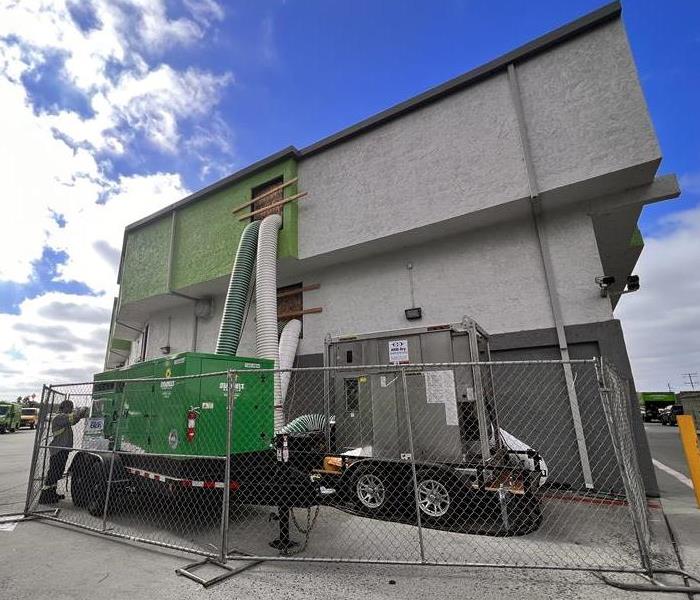 SERVPRO of San Diego East stands ready to assist our fellow San Diego residents in post-storm recovery efforts.
SERVPRO of San Diego East stands ready to assist our fellow San Diego residents in post-storm recovery efforts.
San Diego's reputation for sunny days doesn't shield it from occasional winter storms that can bring unexpected challenges. Understanding these weather phenomena is crucial for preparedness. In this blog, we'll explore the dynamics of winter storms in San Diego and offer insights and tips to navigate these weather events effectively.
Winter Storm Dynamics in San Diego
San Diego experiences distinct characteristics during winter storms, often marked by heavy rainfall. These storms can lead to potential flooding in low-lying areas and increase the risk of flash floods in some neighborhoods due to rapid rainwater accumulation. Strong winds are another hallmark, occasionally causing damage to structures, trees, and power lines. Additionally, hilly or mountainous areas may face a heightened risk of landslides as the soil becomes saturated with rainfall.
Preparation and Safety Measures
Preparing for these winter storms in San Diego requires a proactive approach. Creating an emergency preparedness checklist tailored to the region is essential. This includes securing outdoor items, establishing evacuation plans, reviewing insurance policies, and ensuring readiness with emergency kits. Protecting homes against potential storm damage is critical. Inspecting roofs, clearing gutters, securing windows, and fortifying doors are advisable precautions.
Flood Prevention and Mitigation
Due to the risk of flooding in certain areas, flood prevention measures become crucial. Deploying sandbags, maintaining drainage systems, and securing flood insurance are recommended steps to minimize potential damage. Staying indoors during storms, avoiding floodwaters, staying updated on weather alerts, and having an emergency kit ready are crucial safety practices for residents.
SERVPRO's Role in Post-Storm Recovery
SERVPRO of San Diego East stands ready to assist our fellow San Diego residents in post-storm recovery efforts. With specialized expertise in storm damage restoration, water extraction, mold remediation, and property restoration, our team is equipped to address storm-related challenges promptly and efficiently. We offer local knowledge and a swift response to aid in restoring properties and ensuring a smoother recovery process.
Understanding the dynamics of winter storms in San Diego empowers residents to take proactive measures to protect themselves and their properties. By staying informed, prepared, and vigilant, residents can mitigate risks and ensure safety during inclement weather conditions.
Protecting Your Home: 10 Tips to Prevent Candle Fires
12/20/2023 (Permalink)
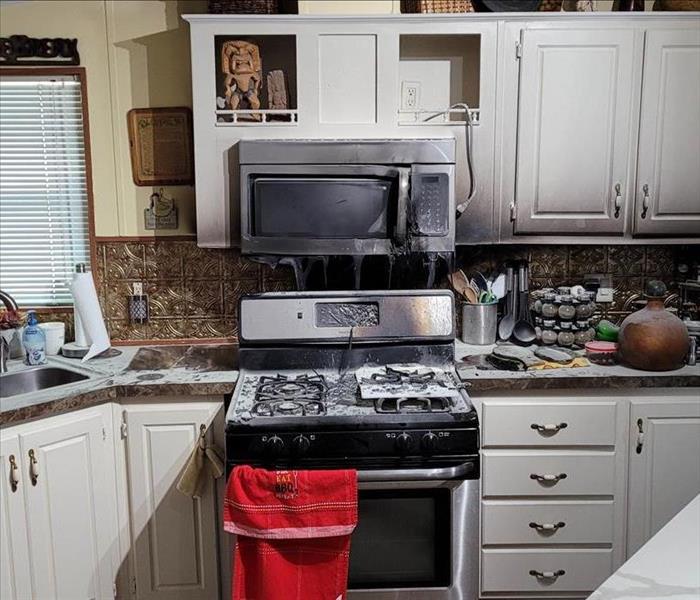 By following these 10 tips, you can enjoy the cozy glow of candles without putting your home at risk of a fire.
By following these 10 tips, you can enjoy the cozy glow of candles without putting your home at risk of a fire.
Your safety is a top priority, and today we're here to discuss a common household hazard - candle fires. Candles can create a warm and inviting atmosphere in your home, but if not handled with care, they can also pose a significant fire risk. In this blog, we'll provide you with essential tips to prevent candle fires and keep your home safe.
- Choose Safe Candle Types
Opt for flameless LED candles, which can provide a realistic glow without the risk of an open flame. They are a safe and energy-efficient alternative to traditional candles.
- Keep Candles Away from Flammable Materials
Place candles at least 12 inches away from anything that can catch fire, such as curtains, tablecloths, and paper products.
- Use Proper Candle Holders
Select sturdy, non-combustible candle holders to secure your candles. Make sure they are the appropriate size for the candle and won't tip over.
- Trim Wick Length
Trim candle wicks to about 1/4 inch to prevent excessive smoke and uneven burning. A long, unruly wick can lead to a larger flame and an increased risk of fire.
- Never Leave Candles Unattended
Always extinguish candles before leaving a room or going to bed. Consider using a timer to ensure they are not left burning.
- Place Candles on Stable Surfaces
Keep candles on a stable, flat surface, away from drafts that can cause them to flicker or tip over.
- Create a "No-Candle Zone"
Keep candles out of reach of children and pets. Educate your family about the dangers of open flames and establish a "no-candle zone" where children should not enter.
- Avoid Overcrowding
Do not place too many candles in a small area. Overcrowding can increase the risk of accidents, especially when moving around.
- Be Mindful of Candle Placement
Avoid placing candles in high-traffic areas or where they can be easily knocked over. This is especially important in homes with young children or pets.
- Install Smoke Detectors
Ensure you have working smoke detectors in your home, especially near areas where you use candles. Regularly check and change the batteries to keep them operational.
Candles can add a touch of ambiance to your home, but safety should always come first. By following these 10 tips, you can enjoy the cozy glow of candles without putting your home at risk of a fire. Remember, prevention is key, but in the event of a fire emergency, contact SERVPRO® of San Diego East for professional fire damage restoration services. Stay safe, and protect your home and loved ones from the threat of candle fires.
How to Get Rid of Mold Smell in Your Home
11/14/2023 (Permalink)
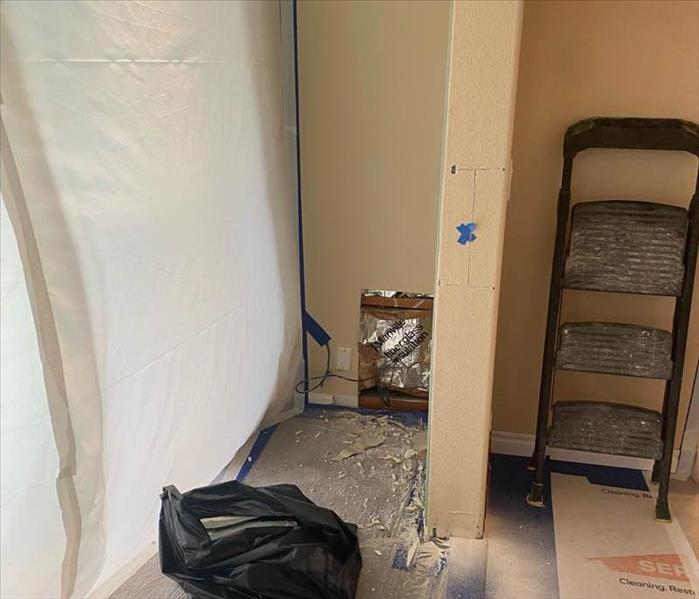 One common issue that can impact your living space is the unpleasant mold smell.
One common issue that can impact your living space is the unpleasant mold smell.
San Diego homeowners take pride in their properties, and maintaining a fresh, clean home is essential. One common issue that can impact your living space is the unpleasant mold smell. In this blog, we'll explore effective ways to eliminate that moldy odor from your home and ensure it stays fresh and inviting.
Identifying the Mold Smell
Mold odor can be quite distinctive and is often described as musty, damp, or earthy. If you notice this odor in your home, here's what you need to do:
- Locate the Source: Start by identifying areas in your home where the smell is most pronounced. Common culprits include damp basements, bathrooms, or areas that have experienced water damage.
- Inspect for Visible Mold: Check for visible mold growth on surfaces like walls, ceilings, or even hidden areas like crawlspaces and attics. Mold may be the source of the odor.
Effective Ways to Eliminate Mold Smell
To get rid of the mold smell, follow these steps:
- Ventilation: Proper ventilation is crucial in preventing and reducing mold odors. Open windows and use fans to increase air circulation in your home. Fresh air can help dissipate the musty smell.
- Remove the Source: If you find mold growth, it's important to address it at its source. Clean and remove the mold using appropriate cleaning agents. If the issue is extensive, consider professional mold remediation.
- Dehumidify: Mold thrives in high humidity conditions. Use a dehumidifier to maintain indoor humidity levels between 30-50%. This will discourage mold growth and help eliminate the odor.
- Baking Soda: Place bowls of baking soda in areas with mold smell. Baking soda acts as a natural deodorizer and can absorb odors effectively.
- Activated Charcoal: Activated charcoal is another excellent odor absorber. You can place charcoal pouches or containers in the affected areas.
- Air Purifiers: Consider using air purifiers with HEPA filters to remove airborne particles, including mold spores, and improve indoor air quality.
- Professional Help: If the mold odor persists despite your efforts, it may be time to consult professionals like SERVPRO® of San Diego East for comprehensive odor removal and mold remediation services.
Getting rid of the mold smell in your San Diego home is essential for a pleasant living environment. By following these tips, you can effectively eliminate mold odors and prevent their return. Remember that timely action and proper maintenance are key to ensuring your home always smells fresh and inviting. If you require expert assistance in addressing mold issues or persistent odors, don't hesitate to contact our SERVPRO® team for professional solutions and peace of mind.
5 Steps to Protect Your San Diego Home from Water Damage
10/10/2023 (Permalink)
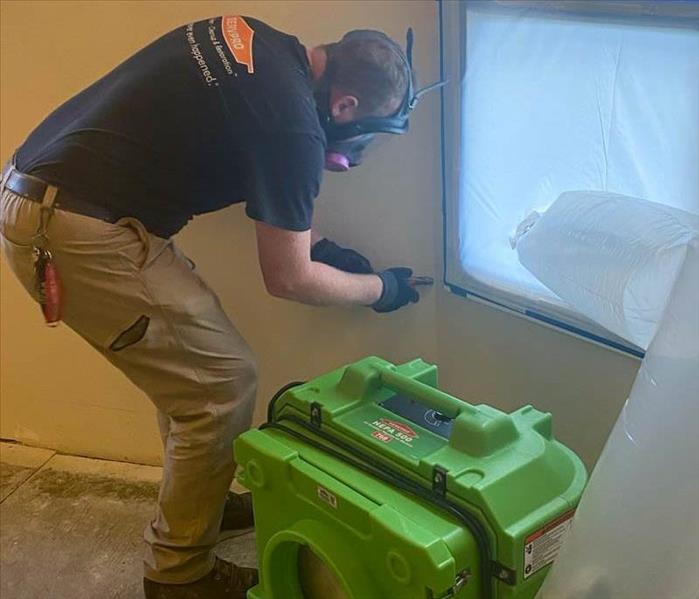 For expert water damage restoration services in San Diego, contact SERVPRO® of San Diego East today.
For expert water damage restoration services in San Diego, contact SERVPRO® of San Diego East today.
As a homeowner in San Diego, protecting your property against water damage is crucial. The city's proximity to the ocean and its susceptibility to rainfall make it susceptible to water-related issues. By enhancing your home's resilience and taking proactive measures, you can minimize the risk of water damage and its costly consequences. In this blog, we will provide you with valuable tips and strategies to safeguard your home against water damage in the beautiful city of San Diego.
1. Regular Roof Maintenance
Your roof is your home's first line of defense against water intrusion. Regular roof inspections and maintenance are essential to identify and address any potential vulnerabilities. Check for damaged or missing shingles, clean gutters, and downspouts regularly, and ensure proper attic ventilation to prevent condensation buildup. Investing in routine roof maintenance can significantly reduce the chances of water leaks during heavy rainstorms.
2. Proper Yard Drainage
San Diego's occasional heavy rainfall can lead to pooling water or flooding in your yard, which can eventually seep into your home's foundation. Ensure that your yard has proper grading to redirect water away from your home's foundation. Consider installing French drains, catch basins, or a rain garden to help manage excess rainwater and prevent water from accumulating near your property.
3. Maintain and Monitor Plumbing Systems
Leaking pipes and plumbing system failures can cause significant water damage if left unattended. Regularly inspect your plumbing for leaks, drips, or signs of corrosion. Ensure that everyone in your household knows the location of the main water shut-off valve in case of emergencies. Consider installing water leak detection systems that can alert you to any water leaks or abnormal usage, providing an early warning system against potential water damage.
4. Waterproofing Basements and Crawl Spaces
If your home has a basement or crawl space, it is important to take measures to prevent water intrusion. Inspect the walls and floors for any cracks or vulnerabilities and seal them with waterproofing materials. Install quality sump pumps and battery backups to prevent basement floods during heavy rainfall or plumbing emergencies. Properly ventilate and dehumidify crawl spaces to prevent moisture buildup and mold growth.
5. Install Flood Prevention Devices
Flash floods can occur during intense rainstorms. Installing flood prevention devices, such as backwater valves and sump pumps with battery backups, can provide additional protection against floodwater backup in your plumbing system. These devices help prevent sewage or stormwater from entering your home, reducing the risk of water damage during a flooding event.
By implementing these strategies, you can protect your property and minimize the potential devastation caused by water-related issues. Remember to prioritize regular roof maintenance, ensure proper yard drainage, monitor your plumbing systems, waterproof basements, and crawl spaces, and install flood prevention devices when necessary. If you do experience water damage despite your best efforts, don't hesitate to contact the water damage restoration experts at SERVPRO® of San Diego East. We are here to help mitigate and restore your property efficiently and effectively.
For expert water damage restoration services in San Diego, contact SERVPRO® of San Diego East today. Our experienced team is available 24/7 to assist you in your time of need.
 Our SERVPRO of San Diego East team can provide detailed advice and services to keep your property in excellent condition.
Our SERVPRO of San Diego East team can provide detailed advice and services to keep your property in excellent condition.






 24/7 Emergency Service
24/7 Emergency Service







